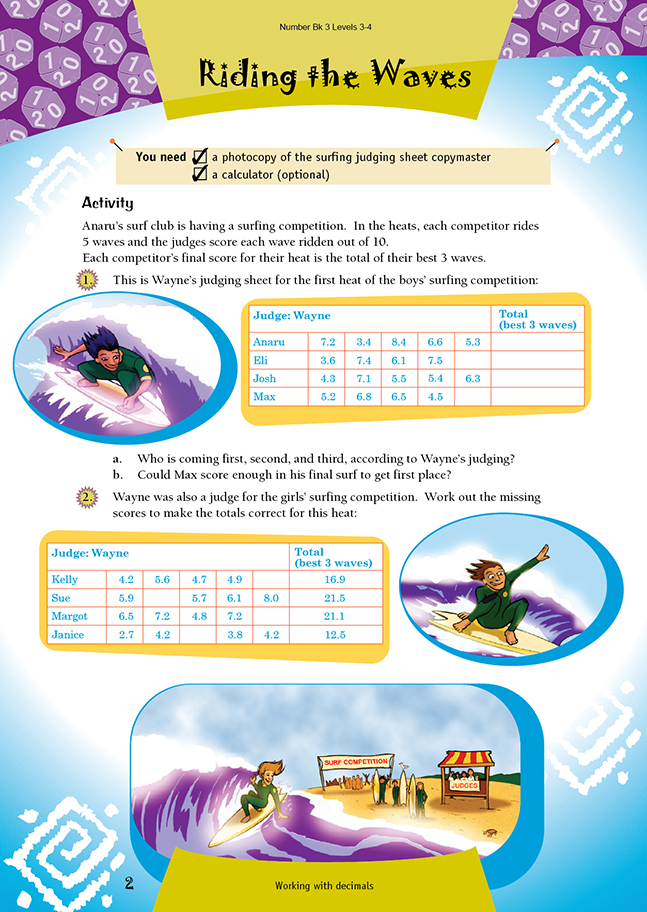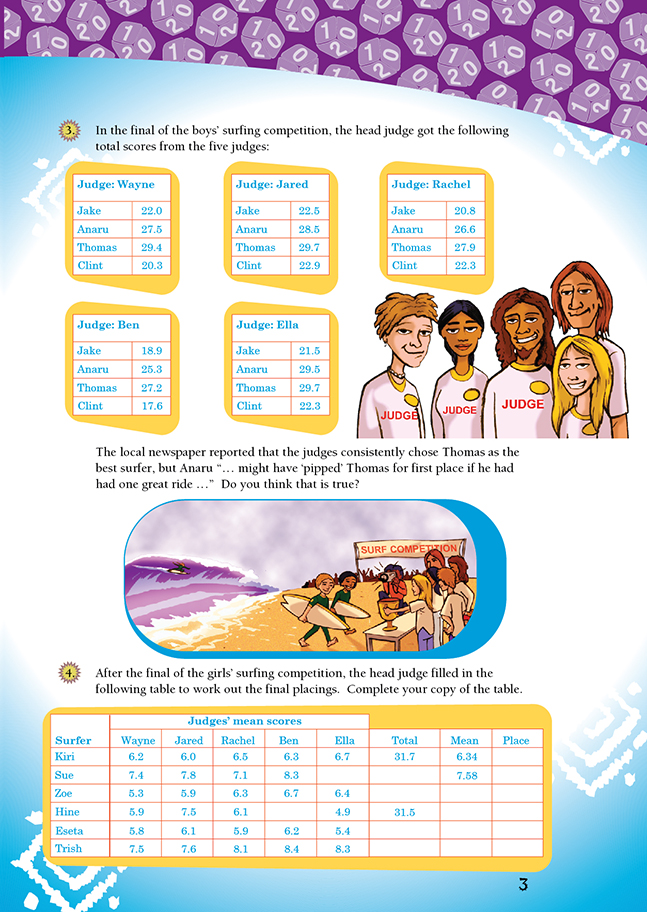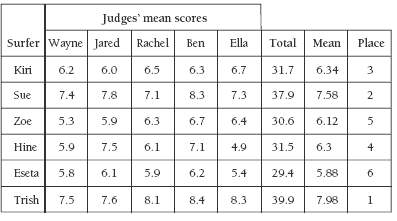This is a level 4 number activity from the Figure It Out series. It relates to Stage 7 of the Number Framework.
A PDF of the student activity is included.
Click on the image to enlarge it. Click again to close. Download PDF (677 KB)
add decimals of one decimal place
FIO, Level 3-4, Number, Book 3, Riding the Waves, pages 2-3
Surfing Judging sheet Copymaster
Calculator (optional)
In this activity, students add, subtract, and divide numbers to 1 decimal place. They could use a calculator for some questions because the focus of the task is on logic and reasoning rather than on calculation. However, encourage them to use mental strategies (such as compatible numbers) for the more straightforward calculations, especially those in questions 1 and 2. The development of mental strategies for adding and subtracting decimals is appropriate for students who have become fluent at the advanced additive stage of the Number Framework. They should be able to
apply their strategies for adding and subtracting whole numbers to similar problems with decimals.
Question 1 requires the students to identify the 3 best scores for each of the 4 contestants and add them up. Make sure they realise that the numerals in the ones column must be considered before the numerals in the tenths column (for example, that 6.8 is smaller than 7.1). Then they can work out, for question 1b, what Max would need to score on his final surf to win and use their judgment based on Max’s pattern of scoring. The rationale for why Max is unlikely to win is given in the
Answers.
In question 2, the students need to devise a strategy to work out the missing numbers given the total of the best 3 waves. A possible strategy is to subtract the highest 2 existing scores from the total in each case to determine whether the missing score is one of the best 3. As it turns out, the missing score in each case is one of the best 3 for each surfer, but the students shouldn’t presume this to be so.
Question 3 involves comparing Thomas’s and Anaru’s scores to determine the overall difference and hence the extra points Anaru would have needed to score from each judge in a single ride to beat Thomas. Again, encourage the students to devise their own mental strategy or strategies for investigating this issue.
Some may decide to mentally calculate the difference on each scorecard and add these together. For example, the scores given by Ben can be added in two parts using standard place value. First, the whole numbers:
Secondly, the decimals: 0.9 + 0.3 + 0.2 + 0.6 = 2.0. So the total is 87 + 2 = 89. This involves knowledge of place value with decimals, which develops at the advanced additive stage of the Number Framework. Other students may total each surfer’s 5 scores and then subtract Anaru’s score from Thomas’s score. Whichever method they use to find the 6.5 point difference, they need to realise that this is over all the judges’ scores so, on average, Anaru is 1.3 points behind Thomas. A fuller explanation for this is given in the Answers.
Question 4 uses mean scores as a way of ranking the surfers. The mean is an average derived from adding up a set of numbers (data) and dividing the total by the number of items in the data set. (This also applies in the explanation for question 3.) The students may need to discuss what the mean is and how it can be calculated. (In this case, it involves dividing the total of the judges’ scores by 5.) They also need to consider what strategies to use to find the missing numbers. For example, they could use trial and improvement to find Sue’s missing wave score (that is, finding what number needs to be added to the other 4 numbers to give a mean of 7.58), but a more efficient strategy is to multiply the mean by 5 to find her total score and then subtract the total of the other 4 scores to find her missing wave score.
In question 1, the students needed to consider the numerals in the ones column before the numerals in the tenths column. In question 4, they need to take this further and look at the numerals in the tenths column before they look at the numerals in the hundredths column. For example, Sue’s mean of 7.58 is less than Trish’s mean of 7.98, and Hine’s 6.3 (which is, in effect, 6.30) is less than Kiri’s 6.34. This is important when it comes to ranking the surfers.
Answers to Activity
1. a. Anaru, Eli, and Josh respectively
b. Max would have to score more than 8.9 in his final surf to better Anaru’s score of 22.2. This seems unlikely, based on his other scores, because his best 2 scores so far total 13.3. The result of Eli’s fifth turn is also relevant. If he scores 7.4 or more, he will beat Anaru, which in turn would mean Max would have to score 9.1 or more to win.
2. Kelly: 6.4; Sue: 7.4; Margot: 6.7; Janice: 4.1
3. Answers may vary. Thomas’s scores added up to 143.9, and Anaru’s scores added up to 137.4. (Each judge scored Thomas higher than Anaru.) For Anaru to beat Thomas, the judges’ scores for Anaru’s “one great ride” would have to have added up to an extra 6.6 (or more) overall or an average of 1.32 (or more) per judge.
4.



